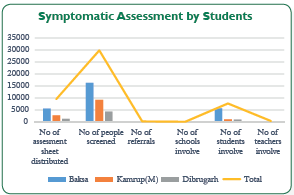Students contribute to TB awareness and screening in three districts of Assam
Students contribute to TB awareness and screening in three districts of Assam
Introducion & Rationale
In order to support the goal of “End TB by 2025”, certain innovative and effective behaviour change operational models were developed to improve the coverage of specific vulnerable populations, across nine Tuberculosis Units (TUs) in Baksa, Kamrup(M) and Dibrugarh for increased case detection, notification, and improved successful treatment outcomes in Drug Sensitive TB (DS TB) and Drug Resistant (DR TB). A socio-behavioural approach has been adopted in engaging the student communities to lead the TB Response in their respective areas. This contributes directly to sensitizing the vulnerable communities on TB, leading to improved active case finding and better treatment outcomes. Students can be prepared as highly productive change agents to promote positive health-seeking behaviour among communities. The teaching fraternity has been extremely supportive of the entire initiative.
Objectives
- Training students as Change Agents in developing and scaling up effective behaviour change operational models to improve coverage of vulnerable populations (4,88,488) across nine TUs in Baksa, Kamrup(M) and Dibrugarh.
- Sensitization and symptomatic screening of the vulnerable population by students.
- Increased case notification, and improved successful treatment outcomes in DS TB and DR TB.
- Establish a robust reporting and responsive mechanism to counter TB, and related health issues in the community.
Overall approach & Key strategies
Efforts are continuously made to orient and inform the student community and the teaching fraternity on TB. Regular visits are made to schools and educational institutions to disseminate the relevant information with the students and teachers. The students from the high schools are encouraged to screen their families and neighbourhood through a symptomatic assessment sheet. These sheets are then, collected by the community structure members from the teachers and referrals of presumptive cases are made to the nearest health facility. A sizeable part of the target population is screened through this approach.
The Key Strategies are
- Approach the Head Masters / Principals of the schools.
- Share in detail the entire approach with all teachers for their support.
- Orient of the students in the presence of the teachers; orientations are conducted joinrly by community structures/ TB Champions/KHPT team and teachers.
- Collectivize students as a pressure group to sensitize families and neighbours on health-seeking behaviour.
- Engage with the TB Champions in meetings and other fun activities.
- Encourage Community Structures to lead the activity for sustained outcomes.
- Engagement of NTEP functionaries in student-led activities.
- Acknowledging the schools with certificates of appreciation.
- Identification of students and teachers with the most contribution as Empowered Champions.
Implementation

Geography covered: Goreshwar, Jalah, Mushalpur, Pandu, Notboma, MMCH, Dibrugarh DTC, Moran & Naharani TUs.
Total Vulnerable Population: 4,88,488
Time Period: June 2022 till December 2022
Key Activities
Promoting positive messaging and awareness of TB amongst students.
- Encouraging symptomatic screening of their families and neighbourhood.
- Establishing a reporting mechanism through schools.
- Supporting referrals through Community Structures/TB Champions.
- Sensitizing the families and neighbours on TB, stigma, gender, etc.
Outcomes
- Excellent Support from teaching fraternity.
- 40 schools, 384 teachers and 7705 students supported the pilot phase, resulting in subsequent planning on larger scale.
- Students form an excellent Pressure Group and have the capacity to transform into great advocates.
- They form a potent force in promoting health-seeking behavior among vulnerable populations.
- This move has been supported by the communities as well.
- The concept has been appreciated by officials of the Bodo Territorial Council, with prospects of scaling up the intervention.
Potential for Replication & scale up
- With high willingness among schools, it has several advantages of being scaled up in all the districts with the right kind of advocacy.
- Leveraging the existing capacities of the Community Structures to coordinate with the schools offers sustainability and greater involvement of the communities.
- Greater demand generation and higher participation in the ‘Care & Cure’ Continuum is led mostly by students.
- There is scope for multi-sectoral collaboration with Social Welfare, Education, Health, PRI and other departments and partners.
- NTEP’s TB Elimination Strategies and NHM’s Ayushman Bharat Program can be better disseminated through this intervention.
- Students can address issues like gender inclusion, stigma mitigation, etc.
- A productive integrated, inclusive and democratic process of Community Health Action can be led by students and teachers.
Key Recommendations
- Orientation and screening exercises can be scaled up as part of the School Health Program, in collaboration with the RBSK and other programmes/agencies.
- The most active students and teachers can be identified as Change Agents and engaged in ACSM activities.
- A cadre of Social Advocates from the communities can be developed.
- There is potential for more participation of students in TB Response
Source : TBC India
Last Modified : 4/6/2024
Information regarding the process to get Caste cer...
Process to apply for Driving License in Barpeta di...
Process to apply for NOC of transfer of Immovable ...
Information regarding the process to get Income ce...
